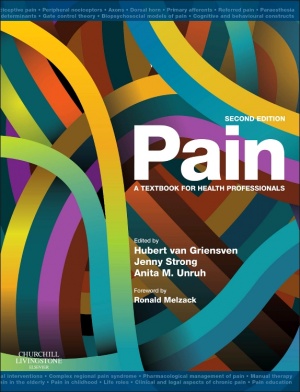Pain Medications: Difference between revisions
(added video and text) |
(added video x 2 and text) |
||
| Line 11: | Line 11: | ||
• Over-the-counter medicines. Good for mild to moderate pain, commonly prescribed for [[Osteoarthritis|arthritis]] and [[Musculoskeletal Physiotherapy Courses|musculoskeletal]] [[Pain Mechanisms|pain]]– nonsteroidal anti-inflammatory drugs (NSAIDS), paracetamol, codeine. | • Over-the-counter medicines. Good for mild to moderate pain, commonly prescribed for [[Osteoarthritis|arthritis]] and [[Musculoskeletal Physiotherapy Courses|musculoskeletal]] [[Pain Mechanisms|pain]]– nonsteroidal anti-inflammatory drugs (NSAIDS), paracetamol, codeine. | ||
{{#ev:youtube|https://www.youtube.com/watch?v=GsfFTcPv5kw|width}}<ref>A Abihu. Over the counter medications: https://www.youtube.com/watch?v=GsfFTcPv5kw (last accessed 8.4.2019)</ref> | |||
• [[Opioids]]. These drugs are often prescribed for acute pain that arises from traumatic injury, such as surgery , neuropathic pain – codeine, morphine, tramadol; | • [[Opioids]]. These drugs are often prescribed for acute pain that arises from traumatic injury, such as surgery , neuropathic pain – codeine, morphine, tramadol; | ||
{{#ev:youtube|https://www.youtube.com/watch?v=XQ9u98rALvo&feature=youtu.be|width}}<ref>Mayo Clinic. Avoid opiates for chronic pain. Available from: https://www.youtube.com/watch?v=XQ9u98rALvo&feature=youtu.be (last accessed 8.4.2019)</ref> | |||
• Anti-epileptic drugs. These are often used for chronic pain eg [[neuropathic pain]] – pregabalin, gaberpentin, carbamazepine; | |||
• Anti- | • Anti-depressants. Used for chronic pain eg [[fibromyalgia]]– amitriptyline, duloxetine<ref name=":0">Australian Pain management association. [https://www.painmanagement.org.au/2014-09-11-13-35-53/2014-09-13-02-37-18.html Medication.] Available from: https://www.painmanagement.org.au/2014-09-11-13-35-53/2014-09-13-02-37-18.html (last accessed 7.4.2019)</ref> | ||
The video clip below gives a good description of pain medication steps using the WHO analgesic ladder | The video clip below gives a good description of pain medication steps using the WHO analgesic ladder | ||
{{#ev:youtube|https://www.youtube.com/watch?v=XCowQo74CaM&app=desktop|width}}<ref>Dr John Campbell. Pain 11 Analgesia. Available from: https://www.youtube.com/watch?v=XCowQo74CaM&app=desktop (last accessed 8.4.2019)</ref> | {{#ev:youtube|https://www.youtube.com/watch?v=XCowQo74CaM&app=desktop|width}}<ref>Dr John Campbell. Pain 11 Analgesia. Available from: https://www.youtube.com/watch?v=XCowQo74CaM&app=desktop (last accessed 8.4.2019)</ref> | ||
== Physiotherapy- pain medication implications == | |||
Remember pain medication is only one part of pain management. Complete pain management needs a three pronged approach. | |||
# Pain medication | |||
# Physical therapy | |||
# Cognitive therapy.<ref name=":0" /> | |||
NB Always be alert to the effects of opiods and antidepressants, both slow reactions, cause sleepiness, and increase falls risks. | |||
See the good informative links below for further information regarding physiotherapy and pain. | |||
[[Medication and Falls|Medication and falls]] | |||
[[Medication and Older People|Medication and older people]] | |||
[[Exercise and Activity in Pain Management|Exercise and activity in pain management]] | |||
[[File:Pain-book.jpg|right|frameless]] | |||
[[Pain Neuroscience Education (PNE)|Pain neuroscience education]] | |||
[[Prescribing in physiotherapy for pain: a current and emerging role|Prescribing in Physiotherapy for Pain]] | |||
[[Pharmacology in Pain Management]] | |||
[[:Category: Pain]] | |||
A 2019 update of pain medications found that new topical NSAIDs provide localized pain relief and are of benefit for pain relief with minimal systemic effects. | |||
* Voltarin gel- pain relief in hands, elbows and knees if used 4 times a day. Physiotherapists can apply this during a therapy session with the added bonus for the client that little systemic uptake occurs reducing or eliminating the adverse GI, cardiovascular, and renovascular effects of the oral compounds. | |||
* Pennsaid ( Topical solution)- applied 4 times daily is an effective pain relief for knee OA. | |||
* Flector patch- good for minor aches and sprains.<ref>Nursing 2019. [https://journals.lww.com/nursing/Pages/articleviewer.aspx?year=2010&issue=11000&article=00024&type=Fulltext An update on pain medications.] Available from: https://journals.lww.com/nursing/Pages/articleviewer.aspx?year=2010&issue=11000&article=00024&type=Fulltext (last accessed 8.4.2019)</ref> | |||
[[Category:Acute Care]] | [[Category:Acute Care]] | ||
[[Category:Pharmacology]] | [[Category:Pharmacology]] | ||
[[Category:Pain]] | [[Category:Pain]] | ||
<references /> | <references /> | ||
Revision as of 07:45, 8 April 2019
What is Pain[edit | edit source]
A definition of pain, according to the subcommittee on taxonomy of the International Association for the Study of Pain and adapted in 1979, is an unpleasant sensory and emotional experience associated with actual or potential tissue damage, or described in terms of such damage. It is usually subjective[1].
What Are Pain Medications[edit | edit source]
A pain medication is defined broadly as any medication that is indicated relieves pain. Many different pain medicines exist and each one has pros and cons. Certain pains respond better to some medicines than others. People also have a slightly different response to a pain reliever.[2]
The main forms of medication are:
• Over-the-counter medicines. Good for mild to moderate pain, commonly prescribed for arthritis and musculoskeletal pain– nonsteroidal anti-inflammatory drugs (NSAIDS), paracetamol, codeine.
• Opioids. These drugs are often prescribed for acute pain that arises from traumatic injury, such as surgery , neuropathic pain – codeine, morphine, tramadol;
• Anti-epileptic drugs. These are often used for chronic pain eg neuropathic pain – pregabalin, gaberpentin, carbamazepine;
• Anti-depressants. Used for chronic pain eg fibromyalgia– amitriptyline, duloxetine[5]
The video clip below gives a good description of pain medication steps using the WHO analgesic ladder
Physiotherapy- pain medication implications[edit | edit source]
Remember pain medication is only one part of pain management. Complete pain management needs a three pronged approach.
- Pain medication
- Physical therapy
- Cognitive therapy.[5]
NB Always be alert to the effects of opiods and antidepressants, both slow reactions, cause sleepiness, and increase falls risks.
See the good informative links below for further information regarding physiotherapy and pain.
Exercise and activity in pain management
Prescribing in Physiotherapy for Pain
Pharmacology in Pain Management
A 2019 update of pain medications found that new topical NSAIDs provide localized pain relief and are of benefit for pain relief with minimal systemic effects.
- Voltarin gel- pain relief in hands, elbows and knees if used 4 times a day. Physiotherapists can apply this during a therapy session with the added bonus for the client that little systemic uptake occurs reducing or eliminating the adverse GI, cardiovascular, and renovascular effects of the oral compounds.
- Pennsaid ( Topical solution)- applied 4 times daily is an effective pain relief for knee OA.
- Flector patch- good for minor aches and sprains.[7]
- ↑ Merskey, H., 1991. The definition of pain. European psychiatry.
- ↑ Medline Plus. Pain relievers. Available from: https://medlineplus.gov/painrelievers.html (last accessed 7.4.2019)
- ↑ A Abihu. Over the counter medications: https://www.youtube.com/watch?v=GsfFTcPv5kw (last accessed 8.4.2019)
- ↑ Mayo Clinic. Avoid opiates for chronic pain. Available from: https://www.youtube.com/watch?v=XQ9u98rALvo&feature=youtu.be (last accessed 8.4.2019)
- ↑ 5.0 5.1 Australian Pain management association. Medication. Available from: https://www.painmanagement.org.au/2014-09-11-13-35-53/2014-09-13-02-37-18.html (last accessed 7.4.2019)
- ↑ Dr John Campbell. Pain 11 Analgesia. Available from: https://www.youtube.com/watch?v=XCowQo74CaM&app=desktop (last accessed 8.4.2019)
- ↑ Nursing 2019. An update on pain medications. Available from: https://journals.lww.com/nursing/Pages/articleviewer.aspx?year=2010&issue=11000&article=00024&type=Fulltext (last accessed 8.4.2019)








